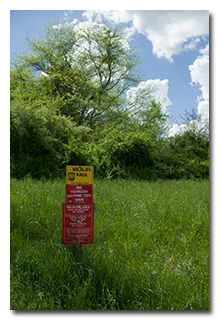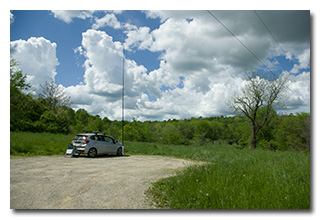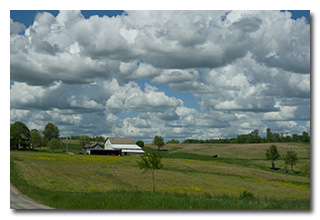
by William Eric McFadden
From the wildlife area's website:
-
This 2,779-acre wildlife area lies between State Route 60 and the Muskingum River, four miles north of Zanesville. County Road 49, which runs east from State Route 60, provides the best access to the heart of the area.
The topography includes gently rolling, reverting old fields and woodland. Seventy-six percent of the land is covered by woodland; of the total, 40 percent is in sawlog-size stands and 60 percent in pole-size stands. Brushland comprises 22 percent of the area. Less than one percent is open land. Approximately one-fifth of the area has been affected by earlier strip mining, leaving the terrain in a rough condition.
In the 1940s some of the spoil banks were planted to black locust and conifers which are now pole size.
Pictures
Description
 On Friday, May 13, 2022, one member of the Southeast Ohio Radio Adventure Team
performed a successful activation of Powelson Wildlife Area in Ohio as part of the Parks on the
Air (POTA; link) program.
On Friday, May 13, 2022, one member of the Southeast Ohio Radio Adventure Team
performed a successful activation of Powelson Wildlife Area in Ohio as part of the Parks on the
Air (POTA; link) program.
Following his successful activation of Muskingum River State Park (K-3520) at Ellis Lock #11 (link), Eric McFadden, WD8RIF, visited Powelson Wildlife Area on a beautifully sunny afternoon. Eric was accompanied by his wife Vickie and their little dog Theo Vickie and Eric's 30th wedding anniversary.
Following a drive of about a mile from Ellis Lock #11, the trio arrived at the Powelson Wildlife Area parking area on Ellis Dam Road at about 1845 UTC. Eric quickly deployed his 28½' wire vertical on a Jackite 31' telescoping fiberglass mast and drive-on mount. Because he had allowed himself to be exposed to too much sun at Ellis Lock #11, Eric chose to set up his KX3 inside the car in order take advantage of the only available shade. Eric was on the air 1856 UTC.
After unexpectedly having had no cell-signal at the nearby Ellis Lock #11, Eric was pleased to find he had good cell-signal at this location, and he was able to spot himself to POTA Spots (link) and to use POTA Spots to identify possible park-to-park (P2P) QSO opportunities.
 Eric was disappointed to find that on this visit, he had an S7 noise-floor on 40m, with noise that sounded like
power-line noise. Rather than fight the noise, Eric opted to begin operations on 30m, where the noise-floor was
only S4. Finding himself a frequency to run on 30m, Eric began calling CQ and spotted himself to POTA Spots. Eric's first
QSO came at 1859 UTC with KX4MI in South Carolina. Even though signal-strengths were almost without exception barely
above the noise-floor, QSOs came quickly, with Eric's seventh QSO coming at 1905 UTC with W9OD in Wisconsin. This run
included QSOs with stations located in South Carolina, Louisiana, New Hampshire, Wisconsin (2), New Jersey, and Illinois.
Eric was disappointed to find that on this visit, he had an S7 noise-floor on 40m, with noise that sounded like
power-line noise. Rather than fight the noise, Eric opted to begin operations on 30m, where the noise-floor was
only S4. Finding himself a frequency to run on 30m, Eric began calling CQ and spotted himself to POTA Spots. Eric's first
QSO came at 1859 UTC with KX4MI in South Carolina. Even though signal-strengths were almost without exception barely
above the noise-floor, QSOs came quickly, with Eric's seventh QSO coming at 1905 UTC with W9OD in Wisconsin. This run
included QSOs with stations located in South Carolina, Louisiana, New Hampshire, Wisconsin (2), New Jersey, and Illinois.
 Switching to 20m, Eric found an S4 noise floor. Finding himself a frequency to run, he began calling CQ and
updated his spot on POTA Spots. His first QSO on 20m came at 1912 UTC with DJ5AV in Heiligenberg, Germany.
Despite the noise, QSOs came more quickly than Eric had anticipated, with his ninth QSO on 20m coming at 1922 UTC
with KB5FCF in Oklahoma. As had been the case on 30m, the signals on 20m were barely above the noise floor. This run
included QSOs with operators located in Germany, Louisiana, Florida (2), Idaho, Texas (3), and Oklahoma.
Switching to 20m, Eric found an S4 noise floor. Finding himself a frequency to run, he began calling CQ and
updated his spot on POTA Spots. His first QSO on 20m came at 1912 UTC with DJ5AV in Heiligenberg, Germany.
Despite the noise, QSOs came more quickly than Eric had anticipated, with his ninth QSO on 20m coming at 1922 UTC
with KB5FCF in Oklahoma. As had been the case on 30m, the signals on 20m were barely above the noise floor. This run
included QSOs with operators located in Germany, Louisiana, Florida (2), Idaho, Texas (3), and Oklahoma.
Eric finished his operation by checking POTA Spots for P2P QSO opportunities, and at 1926 UTC he succeeded in making a P2P QSO on 30m with WB2SMK who was activating Cole Hill State Forest (K-5182) in New York.
In all, Eric made seventeen QSOs, including one P2P QSO. All of Eric's QSOs were CW and were made with five watts output.
Eric also submitted his log to the World Wide Flora and Fauna in Amateur Radio (WWFF; link) program for KFF-5916.
(return)